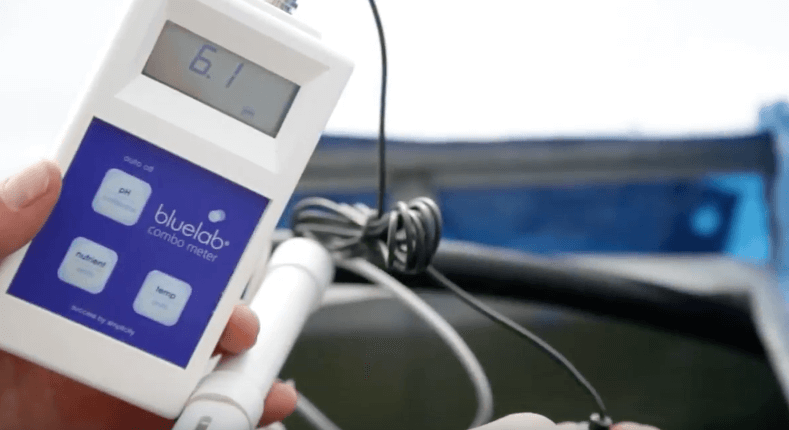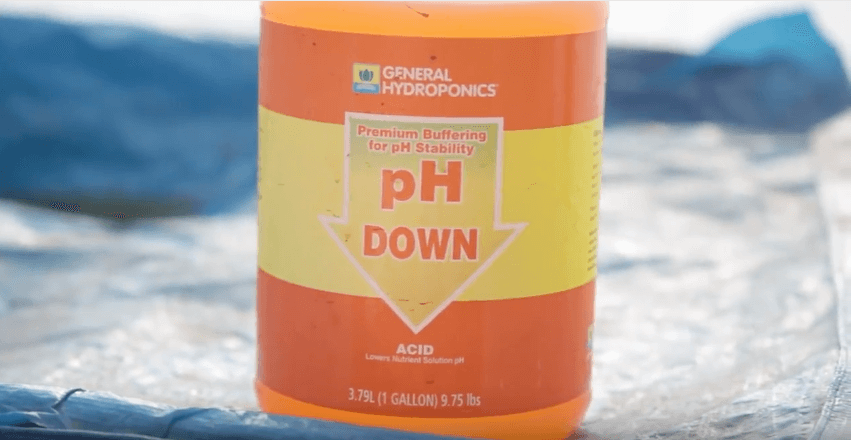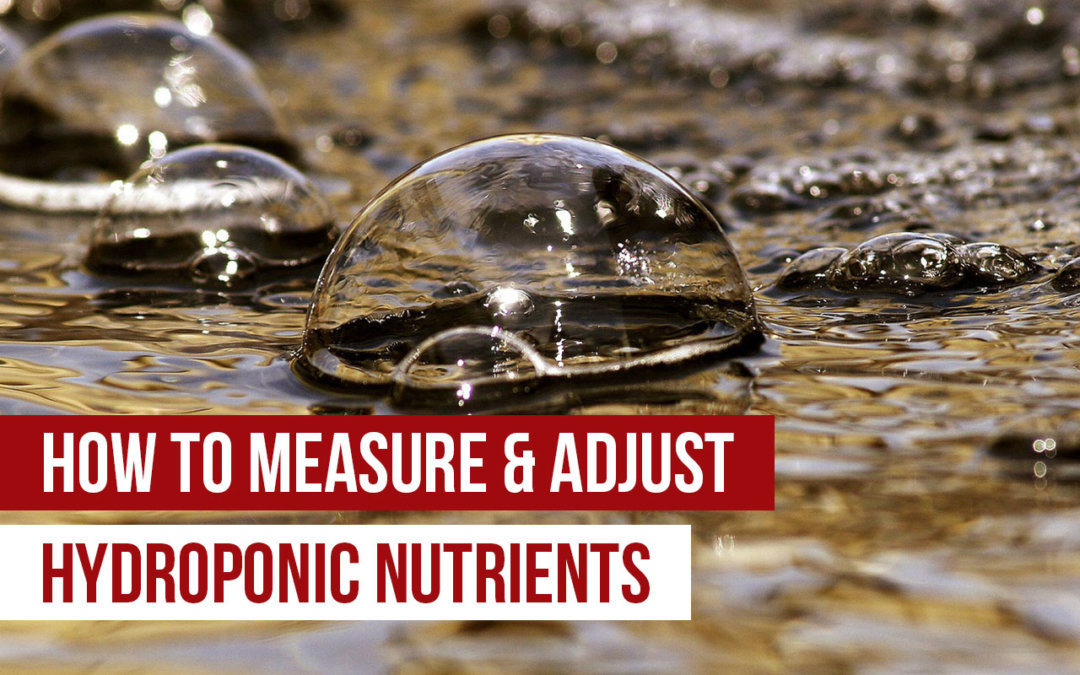Nutrients in Hydroponic Systems
Hydroponic systems use a formulated nutrient mix to fertilize plants.
Although nutrients are formulated in ratios that reflect the needs of the plant, transpiration and crop differences mean that nutrient levels can drift away from the optimal values. A system manager must manage the fertilizer in system water to maximize plant growth.
If you have a hydroponic system, that manager is you. There are several convenient ways to test a system. Let’s learn what those are.
Dr. Nate had Upstart Farmer Haydn Christensen, an experienced hydroponic farmer, walk us through the process of testing a hydroponic system. Haydn tests his system once a day. The frequency with which you test your system is especially important if your system is small, as smaller systems fluctuate more severely than large systems.
Key measurements: pH and EC
The two main measurements a hydroponic grower needs to make are pH and EC levels. Both of these can be done with meters.

pH is the measure of the acidity of a system and determines how plants and other organisms interact with different nutrients. Every crop has a specific pH range, but most herbs and greens overlap within a range. Try to keep pH between 5.5 and 6.5 without changing more than .5 per day. (Drastic changes may shock plants.)
EC is a measure of the salts in your system—that is, the level of nutrients in your system. EC should be kept between 1.2 and 2.0.
EC and pH meters are affordable and often come as one dual meter. Haydn uses a Bluelab dual meter.
Adjusting pH is as simple as adding an acid or base solution

Unless you use an RO filter together with an acidic solution, rarely will you have to worry about raising pH. It’s more likely that you will have to lower pH. While lowering pH requires several steps in aquaponics, lowering it in hydroponics is simple. You can use a pH buffer like pH Down by General Hydroponics, added to your system in a certain quantity, which is decided by how far you wish to lower your pH.
If you do have to raise pH, you can use a base addition instead of an acid addition.
Quick Tip: If your pH is behaving strangely or giving you difficulty, you might have a carbonates problem.
The key to EC is dilution
You can easily lower EC by diluting your system with fresh water. Take measurements intermittently while adding water until it is mixed to the correction level.
You can raise EC by adding fertilizer.
Was this post helpful? Leave ideas and questions in the comments below!



Plz send me detail about hydroponic farming. How can I start hydroponic farming ND what is essential for hydroponic farming like devices equipments ND other related nutrients…
Regards
Hi!
All of the information you’re looking for is available in the Upstart U courses. All you have to do is subscribe!
May I.know how to buy the EC & pH meter that you are using. I live in Malaysia
How can I customise hydroponic plant size?
According to client requirement?
Hi, i have dwc for growing peppers.
I measure the TDS around 1600, and whenever water level drops i keep adding fresh water to keep it full.
i keep measuring the TDS and it is not going down it is going up? is that normal? is the fresh increasing the TDS.
my fresh water TDS is around 93.
thank you.
Hi Jake,
That is strange. TDS should decrease when adding fresh water.
Some of the nutes are settling in your res.. when you ad water you are stirring the salts that settled giving you higher ec… flush system and go back to an ec of 1.2 and see how its goes.. always keep check on ph.. if ph is out of whack it will cause some nutes to build up because they are not readily available because of incorrect ph
That’s not the way it should be working are you using tap water or well water?
is not just nutrients settling to bottom. if it is going up, plants will use just water with very small amount of nutrient at times but also the leafs respire ( breath ) and give off water vapor into the air and in affect can gradually cause the liquid to concentrate , now add to it the 93 ec from meter reading and you add each time you have add more water and build up dissolved solids to the deep water system. depending where you live and type of water source , shallow well deep well city supply the make up can vary so you could be adding dissolved solids the plants do not need and also as justin says watch your PH as for EC i prefer EC versus TDS because there are 4 unique scales of tds ( ppm ) and do not convert proper to a real time EC ( electrical conductivity ) of a solution even at 1600 tds for ppm that is well below the basic guidelines of peppers. as for the concentration i use i run between 1800 ( 1.8 ) and 2500 (2.5) EC depending what stage of growth the plants are at and if in bloom or fruit stage so. step back get a meter you can read EC another for PH and monitor both.
hi
my fresh water ph is 4.9. i use 0.1% sodium hydroxide to adjust ph to 6.2 for hydroponic. my problem is when adjusting ph my EC going up with every drop of NaoH. for eg. 0.5g of hydroponic nutrient ( Alberts Solution) gives a Ec around 1.5ms. once i add NaoH to raise ph Ec changes to around 3.5ms. what should i do
Hi Janaka. Sodium anything is generally not good in hydroponics. Try potassium hydroxide or potassium bicarbonate. It will still raise the EC some but hopefully not as much. Keep in mind that it will also increase potassium levels, so watch out for magnesium deficiencies.
what do you think about changing the type of fertilizers? does it work?
The base EC of my well water is a little over .8, does that mean a target fertilizer EC of 1.6 should be in addition to the base number or including the base number?
I have a study from Cornell where they are calling for 1.2 “above source water EC” for lettuce seedlings so now I’m questioning all my numbers.
Hi Mel,
Your target EC should be including your base EC.
Two factors here, one is the maximum salt concentration that a plant can tolerate(this changes with variety) this is an upper limit on total EC without regard for the nutrient balance.
The other issue is proper nutrient balance, this comes from added EC. This second issue can be mitigated if you know the chemistry of the source water and get a nutrient formula that is adjusted. example: if the water is naturally high in magnesium ions the nutrient solution would be formulated with less added Mg (or even none). If a mineral is in gross excess then the only solution is to use better water, either by changing sources or with reverse osmosis. No need to RO all of the water, only need to mix in enough RO water to dilute the problem mineral into the desired range.
Electrical conductivity is just that and not a direct measure of ppm(mass/mass), molarity(number of molecules per volume), or osmotic potential(pressure that can harm cell walls), thus EC is only useful for comparing apples to apples, that is different dilutions of one formula is fine but two different compounds are not comparable without additional conversion info.
Knowing the primary native minerals in the water, maybe having a proper chemical test on the water, can remove much of the guessing. Some minerals change the the EC much more than others, recommended EC ranges are for typical nutrient blends not random well water minerals. ie 500ppm (a mass measure) of sodium chloride is needed for an EC of 1.0, but 700ppm of 442 is needed.(442 is a mix of 40%sodium sulfate, 40% Na bicarbonate and 40%NaCl) Weakly ionizing salts like zinc sulfate or citric acid may require 1500ppm, while strong bases and acids like lye and sulfuric acid may only need 200ppm for an EC of 1.0.
Can the specific gravity by refractometer be used to monitor nutrients, rather than EC? If so, what would be the appropriate sg for nutrients in a system where tomatoes and green peppers are grown?
Thanks!
in my hydrophonic systeam i used pump to uplift water from a bucket of 20 lts.water run through the pipe &fall into bucket & lift again let me know duration of water supply in systeam & how many times (frequancy) i have to run water. also let me know quantity of N P K to be mix in a bycket of 20 lts. Thanks
what do you think about changing the type of fertilizers?
When you say EC of 1.0 do you mean 1.0 µS/cm or 1.0 mS/cm?
I have a small hobby grow room where I am growing cherry tomatoes, green beans and swiss chard. Things seem to be doing fairly well. I just recently harvested swiss chard and beans. I know absolutely nothing about chemistry. I have been able to adjust the Ph. But when it comes to PPM I am lost. I have a TDS & EC (hold) meter and I have read & studied everything I can find about it. But the more I read the more confused I get. Instructions with the meter are very vague. I have tried using the meter just as it is and I don’t know if it is giving a correct reading or not. I have tried. calibration but I don’t know if I am calibrating it correctly. I have three different bottles of calibrating liquid. When I study what is on the net, in every case the method is different, the meters are different which leaves things even more muddled. Is there any way or anyone that can help straighten things out for me?
Wally.
Dear Katie
how i can control or adjust the nutrition elements after adding in the system?like suppose there is consumption for one of the nutrition elements more others like Mg or Ni how i can detect it while system is going on??is there device or methods?
thanks
There is no device to help you. the best way is that you get a sample and send it to the laboratory.
how do i pick up my ec and ppm my watar ph is 6.8
ec is0. 688
and ppm is 420 hydroponic water system
lettace
Need to edit the video you don’t use a base solution to lower your pH.
oh wow, I like your blog post best knowledge share. thanks